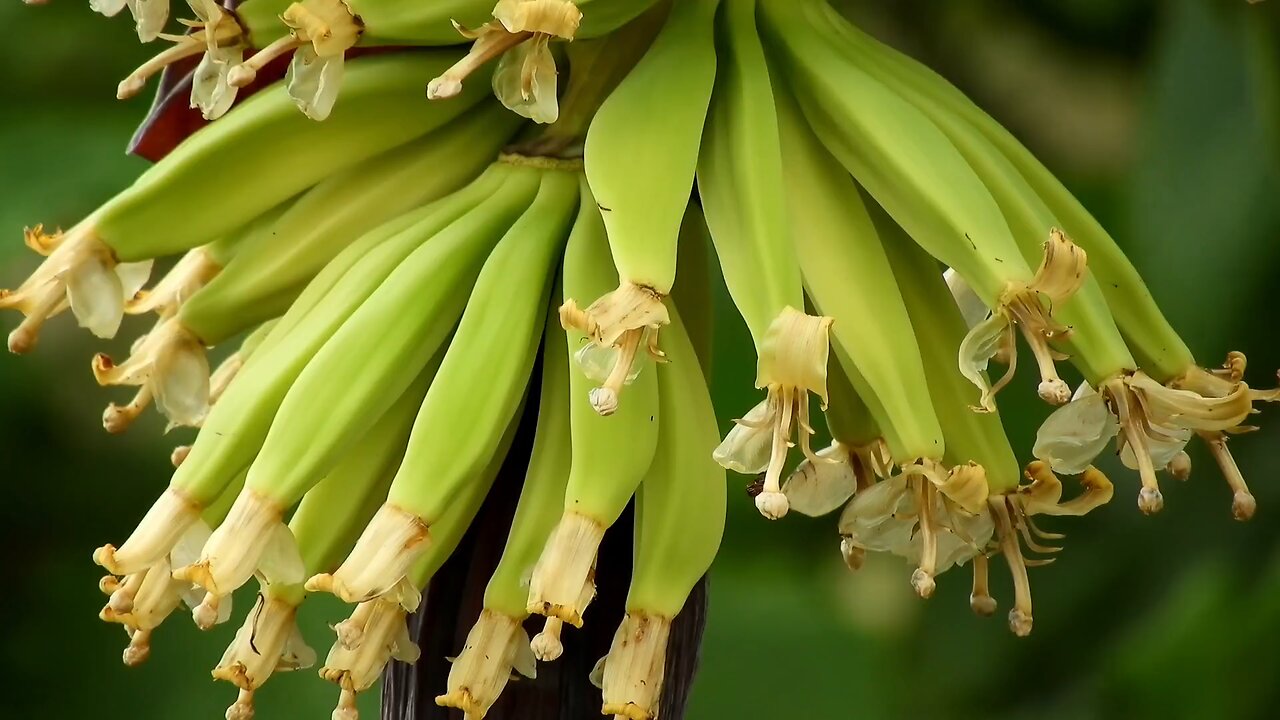Premium Only Content

"Banana Plants: More Than Just Fruit"
The banana plant, *Musa spp.*, is a large herbaceous flowering plant that belongs to the family Musaceae. Here’s a detailed overview of this fascinating and economically important plant:
### **Physical Characteristics:**
- **Pseudostem:**
- The banana plant does not have a true woody stem. Instead, it has a pseudostem, which is made up of tightly packed leaf bases. This pseudostem can grow to heights of 2 to 8 meters (6.5 to 26 feet), depending on the species and cultivar.
- The pseudostem is strong enough to support the heavy banana bunches that the plant produces.
- **Leaves:**
- Banana leaves are large, elongated, and can grow up to 2.7 meters (9 feet) long and 60 cm (2 feet) wide. The leaves are arranged in a spiral and can be easily torn by the wind due to their size.
- The leaves emerge from the center of the pseudostem and unfurl as they grow.
- **Inflorescence:**
- The banana plant produces a large, pendulous inflorescence, often referred to as the "banana heart" or "banana blossom."
- The inflorescence emerges from the top of the pseudostem and consists of several rows of flowers covered by purple or reddish bracts.
- The flowers are arranged in clusters, known as hands, and can be either male or female, though some species also have hermaphroditic flowers.
- **Fruits:**
- The fruit of the banana plant is botanically a berry. The fruits are typically elongated and slightly curved, with a smooth outer peel that can be yellow, green, red, or even purple when ripe, depending on the cultivar.
- Inside, the fruit is usually white or cream-colored and contains small seeds in wild species. However, most cultivated bananas are seedless.
- Bananas grow in clusters, known as "hands," with each hand containing 10 to 20 individual fruits, called "fingers."
- The entire cluster of hands is called a "bunch," and a mature banana plant can produce a bunch that weighs between 30 to 50 kg (66 to 110 pounds).
### **Habitat and Distribution:**
- **Origin:**
- The banana plant is native to Southeast Asia, particularly the region encompassing Malaysia, Indonesia, and the Philippines. It has been cultivated for thousands of years and has spread to tropical and subtropical regions worldwide.
- **Cultivation:**
- Bananas are grown in over 130 countries, with the leading producers being India, China, Indonesia, Brazil, and the Philippines.
- The plant thrives in warm, tropical climates with rich, well-drained soil and plenty of sunlight. It requires substantial rainfall but can be cultivated in irrigated fields in drier regions.
### **Types of Bananas:**
- **Dessert Bananas:**
- These are the most common type of bananas and are usually eaten raw when ripe. The Cavendish banana is the most widely known and consumed dessert banana globally.
- **Plantains:**
- Plantains are starchy bananas that are typically cooked before eating. They are larger and firmer than dessert bananas and are a staple food in many tropical regions, particularly in Africa, the Caribbean, and Latin America.
### **Economic and Cultural Importance:**
- **Staple Food:**
- Bananas are a significant source of food for millions of people around the world. In many tropical countries, they are a staple food, providing essential nutrients such as carbohydrates, potassium, and vitamin C.
- **Economic Value:**
- Bananas are one of the most important fruit crops globally, with millions of tons produced each year. The global banana trade is a major economic activity, with bananas being the most exported fruit by volume.
- **Cultural Significance:**
- In many cultures, the banana plant has symbolic and cultural importance. In some regions, it is associated with fertility and prosperity, and its leaves and fruits are used in religious ceremonies and traditional medicine.
### **Propagation:**
- **Vegetative Propagation:**
- The banana plant is usually propagated vegetatively, using suckers (shoots that grow from the base of the plant) or tissue culture techniques. This method ensures that the new plants are genetically identical to the parent plant.
### **Challenges and Pests:**
- **Diseases:**
- The banana plant is susceptible to several diseases, the most notable being Panama disease (Fusarium wilt), which can devastate entire plantations.
- Other common diseases include Black Sigatoka, Banana Bunchy Top Virus (BBTV), and bacterial wilt.
- **Pests:**
- Banana plants are also vulnerable to pests such as the banana weevil, nematodes, and aphids. These pests can cause significant damage to the plant and reduce fruit yield.
### **Environmental Impact:**
- **Monoculture Issues:**
- The widespread cultivation of the Cavendish banana in monoculture plantations has led to concerns about biodiversity loss and the vulnerability of crops to disease outbreaks.
- Sustainable farming practices, including crop rotation and integrated pest management, are being promoted to address these issues.
### **Uses Beyond Food:**
- **Banana Leaves:**
- In many cultures, banana leaves are used as eco-friendly plates, food wrappers, and for cooking certain dishes. The leaves are also used in traditional ceremonies and decorations.
- **Banana Fiber:**
- The fibers from the banana plant are strong and durable, making them useful for making textiles, ropes, and paper products.
The banana plant is a versatile and vital plant that plays an essential role in both agriculture and culture worldwide.
-
 21:24
21:24
The Based Mother
1 day ago $3.67 earnedThis is not a drill - California is set on self-destruction.
21.9K18 -
 35:23
35:23
CutJibNewsletter
1 day agoWhere Crosses and Cities Burn, soon People Burn, and Dems have the Matches
271 -
 6:06:49
6:06:49
Sgt Wilky Plays
17 hours agoFirefight Friday
89.6K6 -
 5:03:49
5:03:49
Drew Hernandez
20 hours agoLA MAYOR PUSHED $49 MILL LAFD BUDGET CUT ONE WEEK BEFORE FIRES?
137K88 -
 2:52:04
2:52:04
Nobodies Gaming
15 hours ago $7.15 earnedNobodies Rumble Gaming TEST STREAM 2.0
85.7K3 -
 1:00:36
1:00:36
Talk Nerdy 2 Us
14 hours agoDigital Surveillance, TikTok Shutdowns & The Hackers They Don’t Want You to Know About!
69.2K10 -
 3:08:37
3:08:37
SpartakusLIVE
17 hours agoDelta Force || Tactical, Strategic, HARDCORE
69.2K2 -
 3:32:05
3:32:05
I_Came_With_Fire_Podcast
21 hours agoTRUMP GUILTY Verdict, LA Fires, New American EXPANSIONISM, and Cyber Truck Updates!!
43.4K28 -
 1:26:05
1:26:05
Glenn Greenwald
17 hours agoGOP Senators Demand Tulsi Support Domestic Surveillance To Be Confirmed; Group Tracks IDF War Criminals Around The World; System Pupdate: Pointer's Determination To Survive | SYSTEM UPDATE #387
158K156 -
 57:27
57:27
Flyover Conservatives
1 day agoHealthy People Are Ungovernable: The Secrets They Don’t Want YOU to Know - Tracy Beanz | FOC Show
87.1K7